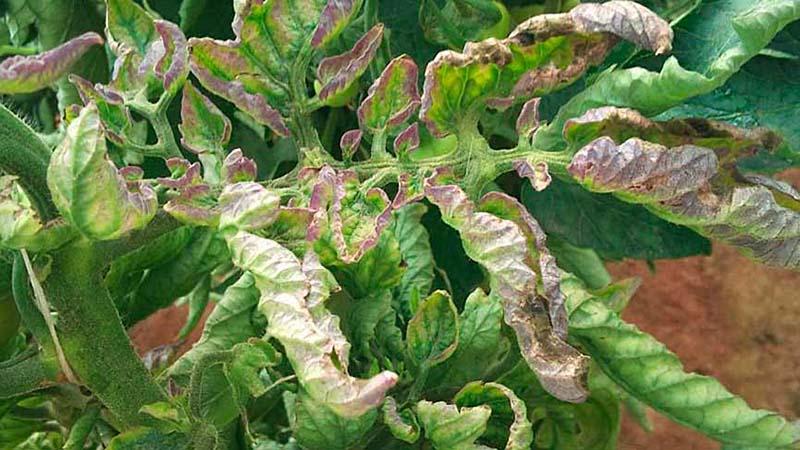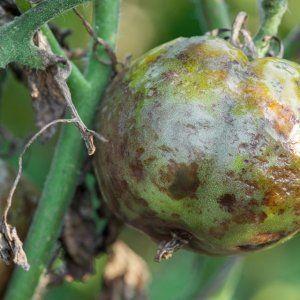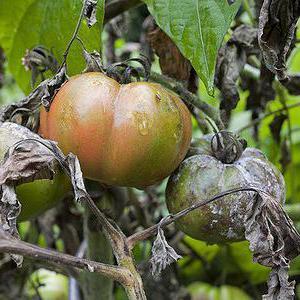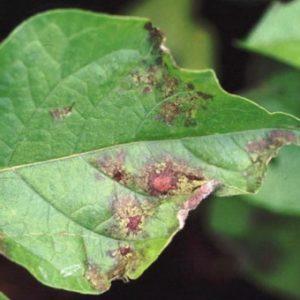How and how to deal with late blight on tomatoes in a greenhouse: the best methods and reviews of gardeners
In history, there are cases when the phytophthora fungus was the cause of the famine of an entire state. For example, in the 19th century in Ireland, he destroyed the potato crop. Today, late blight most often affects tomatoes and zucchini.
Gardeners use many tools and methods that help prevent late blight or cure the plant when it has already happened.
The content of the article
What is this disease
Late blight is the most common disease affecting plants. It was first discovered in Europe and Central Asia. The fungus is dangerous for raspberries, strawberries, conifers and deciduous trees, potatoes, peppers and many other crops.
How does it affect tomatoes
The development of the fungus leads to the death of the bushes... If you do not fight the infection, it will destroy even the fruits, regardless of their degree of ripeness. Large brown and brown spots appear on tomatoes. The last stage is decay. Plants cannot be cured. Sometimes the fungus destroys 50-80% of the entire crop.
Symptoms and external signs
Late blight manifests itself as yellow and brown spots on the leaves. Also, in some cases, a white bloom is formed. In addition, a universal sign is the appearance of transparent mold, similar to a cobweb.
The affected parts of the bush die off in a short time, which entails the death of the entire plant. Tomatoes themselves lose their appearance and taste.

Reasons for the appearance and infection
Let us consider further what causes the disease and how to prevent it.
Causative agent of the disease
The causative agent is the Phytophthora fungus. The disease is spread by spores. The pathogen enters the plant through the stomata and gradually spreads throughout the bush. Also, the spores are washed off by rains and dew into the soil, and then infect the nearby beds. Spores affect any part of the bush.
Terms of distribution
Provoke the appearance phytophthora on tomatoes, high humidity and high air temperature. That is why in hot and rainy summers it is advised to reduce the amount of watering and pay special attention to tomato bushes.
Most often, late blight manifests itself precisely in the second half of summer, when the weather is hot.Fogs or dew, as well as sudden changes in temperature, are also excellent conditions for the spread of the fungus.
Important! Phytophthora affects weak bushes most quickly. Tomato health depends on quality soil, the availability of fertilizers and appropriate care. To increase immunity, feed vegetables with organic matter and minerals, regularly loosen the soil and remove weeds.
Another condition for the spread of the fungus is contaminated soil. That is why it is necessary to collect all garden debris and foliage in the fall. Remnants of plants and last year's soil can contain spores and other dangerous microorganisms. The disease can appear both in the northern and southern regions of the country.
How and what to treat
What if vegetables are struck by late blight? Fortunately, there are a huge number of professional drugs and folk recipes that can cure late blight.
Chemicals
 Popular among chemicals are “Fitosporin-M". It comes in powder, paste or liquid form. The action starts from the moment of processing. The product can be used in any weather conditions.
Popular among chemicals are “Fitosporin-M". It comes in powder, paste or liquid form. The action starts from the moment of processing. The product can be used in any weather conditions.
The remedy “Fundazole". The therapeutic effect is manifested within the first three days. The protective function begins in the next 7 days. "Fundazol" is safe, but phytotoxic when applied excessively to the soil. It can be used both in late spring and early autumn.
A drug "Planzir"- the most powerful remedy for late blight. It can be applied at any stage of plant development. It is low-toxic and effective not only in the fight against late blight, but also against other types of fungal infections. It must be used strictly in accordance with the recommendations on the packaging.
Another effective fungus-fighting chemical is the well-known “Quadris". Provides preventive and curative effects. It is recommended to use the drug no more than two times, otherwise the fungus becomes addictive. Safe for all types of crops, effective when mixed with other fungicides.
Important! The drugs listed above are fungicides. This is a special group of agents aimed at treating fungus. They are preventive or protective. You can use fungicides for spraying or supplementing irrigation. In addition, they are added to top dressing. The funds are characterized by low toxicity and availability. Sold at any gardening store.
Folk methods and agrotechnical techniques
The methods are popular in that they are absolutely safe for both plants and humans. After processing with folk remedies, you can eat tomatoes and not worry about your health.
We present the TOP-5 effective folk remedies against late blight:
 Spraying with whey-based solution. Getting on the leaves, the liquid forms a protective film, and it becomes difficult for spores to penetrate into the plant. The method is used mainly in the early stages of infection, since special chemicals are used for a stronger effect. For example, a mixture of whey and Fitosporin M is often used.
Spraying with whey-based solution. Getting on the leaves, the liquid forms a protective film, and it becomes difficult for spores to penetrate into the plant. The method is used mainly in the early stages of infection, since special chemicals are used for a stronger effect. For example, a mixture of whey and Fitosporin M is often used.- Spraying based on hay, grass and urea. To make the product, you will need a bucket of water, 1 kg of grass or hay, 20 g of urea. After the mixture is infused for 3-4 days, it is filtered. Apply every 2 weeks.
- Wood ash based mortar. When ash is diluted in water, not only an effective remedy for fungus is obtained, but also a drug that affects the overall health of plants. Wood ash is an excellent product for tomatoes; top dressing based on it is applied even at the stage of seedling preparation.
- A mixture of garlic, potassium permanganate and water. Manganese has a strong disinfectant effect, and garlic protects the leaves from spore penetration. It is recommended to process bushes with such a mixture every 10 days. If there is frequent rain, the interval is shortened.
- Spraying based iodine... To do this, dissolve 1 teaspoon of iodine in 10 liters of water. Store the solution in a dry and dark place, and spraying is carried out every 8-10 days.
Agrotechnical methods include the burning of infected plant parts. If you see that late blight has "conquered" the entire bush, immediately remove it from the garden. Also treat the ground and hard surfaces: greenhouse walls, pegs, doors, and so on.
Preventive measures
Fungal spores persist not only in soil and plants, but also in garden tools. For example, on irrigation devices. Therefore, before planting a crop, be sure to observe the following measures:
 Collection of garbage, weeds, plant residues.
Collection of garbage, weeds, plant residues.- Their elimination away from the place where vegetables are supposed to be planted.
- Treatment of the ground and all hard surfaces with disinfectants, for example, a manganese-based solution.
- Disinfection of seeds at the stage of seedling preparation. It is advised to decontaminate the inoculum by soaking in hydrogen peroxide.
- Choose a bright, warm place for planting tomatoes. Avoid areas near groundwater or bodies of water.
- If the tomatoes are planted in a greenhouse, ventilate it regularly.
- Watch the watering regime. Do not allow the earth to become waterlogged or dry out.
Use Trichopolum as a preventive measure. This medicine is sold in any pharmacy, it is dispensed without a prescription. It is used both for open ground and for greenhouses and hotbeds.
"Trichopol" is used throughout the garden season. In addition to tomatoes, they are processed with cucumbers and zucchini. The bushes are initially watered at the beginning of the summer season. It is produced in the form of tablets, which are crushed in water.
To save the harvest, a drug called "Gamair" is used, which suppresses pathogens without harming the plants. Available in dry powder or tablet form. 10 liters of water requires 2 tablets.
For the strongest effect, liquid soap is added to the solution. Spraying is organized in early spring 2-3 times with an interval of 7 days. Promotes the restoration of plant microflora, removes soil toxicity, is safe for humans and plants.
Gardener tips
 Experienced gardeners recommend wrapping the roots of the seedlings with copper wire before planting. Some people simply pierce the stem of a tomato with it. How it works? Copper normalizes plant respiration, enhances oxidative processes.
Experienced gardeners recommend wrapping the roots of the seedlings with copper wire before planting. Some people simply pierce the stem of a tomato with it. How it works? Copper normalizes plant respiration, enhances oxidative processes.
As a result, the bushes stop growing and become more resistant to fungi. They pierce the stems only after they have become powerful. Never wrap the wire around the stem.
In addition, Bordeaux liquid occupies an honorable place among the remedies. It is a mixture of water, copper sulfate and lime. The solution is purchased at a store or prepared independently.
The drug is dangerous to humans, therefore, when using it, you must observe safety precautions - use protective clothing, glasses, and a respirator. Use Bordeaux mortar at least 2 weeks before harvest.
Important! Often tomato growers are advised to use a saline solution. You will need a bucket of water and a mug of table salt. The mixture will not only help get rid of the disease, but also protect the bushes.
Conclusion
How to deal with a fungus? All is fair in this matter. Pay attention to preventive measures. Even at the seedling stage, take care of the plants - temper them and feed them on time. Create all the necessary conditions for the plant for normal development. Remember about watering, do not allow excess moisture. This is especially true for hot periods.
If late blight nevertheless struck the plant, immediately perform wellness procedures. If there are no special preparations at hand, use a regular garlic solution or potassium permanganate. It is easiest to prevent late blight in the early stages.